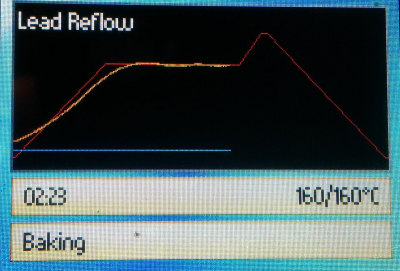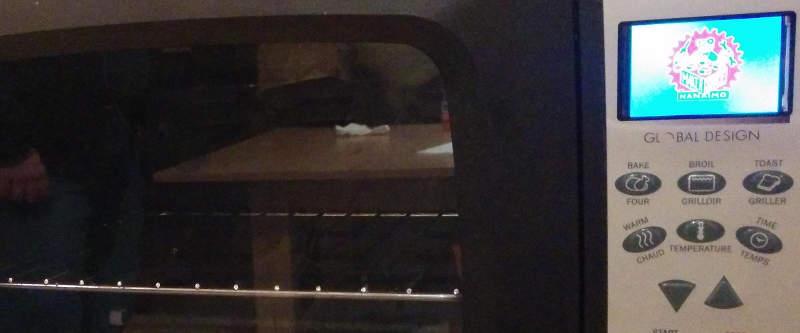Using a toaster oven to reflow solder isn’t a new idea. But [Sukasa] wanted something that had more features and improved appearace. So he married a Netduino, a toaster oven, and some solid state relays to made a clean-looking reflow oven. His goal was to have nothing look like an overt modification to a casual observer. Inside, however, the oven now has a network connection for system status via a Web browser or JSON.
The new brains of the oven are a Netduino Plus 2 and an I2C port expander that connects to a few extra I/O devices. The challenging I/O, though, is the heaters. When cold, the oven can draw over 16 amps, so a pair of 12A solid state relays in parallel handle that load. There are also two fans: one to keep the electronics cool and another on software control. An IGBT allows the controller to pulse width modulate the fan’s output. A pair of MAX31855s read the thermocouples that report the temperature.
 The controller was a mashup of the existing oven’s keypad and an add-on LCD display (see right). One thing we didn’t see was a schematic. Of course, you can read the code and figure out how it is all connected and (unless you use the exact same oven) you are probably going to need to modify things to suit your particular setup, anyway.
The controller was a mashup of the existing oven’s keypad and an add-on LCD display (see right). One thing we didn’t see was a schematic. Of course, you can read the code and figure out how it is all connected and (unless you use the exact same oven) you are probably going to need to modify things to suit your particular setup, anyway.
We’ve seen other good looking reflow oven and controller builds in the past, including one with a touchscreen. It is also worth noting that you can find reflow ovens at relatively low prices now if you don’t feel like rolling your own.

















Am I the only one who thinks that hackaday.io projects are totally unreadable? I think this might be an interesting project, but the representation as a separate gallery and a wall of text does not really make an enjoyable reading.
Couldn’t agree more.
hear, hear! i dread them too and feel tricked when the links don’t go to blogs where there’s a much better chance at finding and enjoying project write-ups.
+1
+1
+1
+2
The format is awful.
+1
+1
It keeps me from using it, despite the like-minded community.
+1
Well documenting project well is skill of its own. Consisting more then just take some pictures and slap some text to go with them…
+1
+1
I use it and it’s still very confusing to try and follow the order of things.. I end up reading progress logs in reverse constantly, it’s just all very disconnected at times..
no you arent, .io is pretty much barbage. You can vomit some info there, but there is no way to follow it coherently
I agree, completely unreadable.
This string of “+1” comments is depressing, expressing discontent without offering any suggested improvement. The HaD team might be willing and able to work on the site format, but there’s nothing here for them to go on.
Having said that, hackaday.io is not something I’m willing to use in its current form.
Giant, nagging banner at the top of the project. Fills the entire screen on mobile. Does not spark my interest in membership.
Massive text styles with massive padding don’t facilitate presentation of dense technical information. Everything goes into an endless column of disconnected chunks. Why do I have to scroll past the parts list to see new log entries? That information could go on the left hand side under the gallery, in a smaller text size.
I assume there’s no themeability, since all the hackaday.io projects I’ve seen look exactly the same. Grey text on grey background ought to be accessible enough for anybody, on any platform!
No inline images? No dates on gallery images? How can you chronologically relate images to your build log? Do these features exist, and no one uses them?
Every contest HaD runs comes off like a desparate ploy to increase membership and submitted content for hackaday.io. What’s the underlying goal? Is it possible to enter a HaD contest if I host my project on an external site? If hackaday.io is mandatory for these activities, good design and customizability seem like reasonable conditions for donating our precious content.
One note of criticism toward the actual project: solderless breadboards aren’t particularly reliable, and aren’t suitable for permanent use–particularly in a setting where frequent thermal cycling might be expected. I can see a lot of thought and work went into the project. Such effort deserves permanent construction methods.
Thanks for the feedback!
I probably will upgrade from the breadboard to a proper PCB in the future. It’s a good point, and one that I (unfortunately) overlooked when taking this from ‘WIP’ to ‘Finished Product’
If only there was some way you could produce your own PCB…
+1
To basically everyone (but those with an actual comment the most):
All the whining about formatting makes me sad… Have you actually looked at the projects documentation? It’s like a tiny blog. Blogs always show the latest entry first. So saying “it’s not leading to a blog!” is weird. (alfred)
The banner is just not there when you are logged in, so I don’t see a reason why this should stop you from registering.
The parts list is something I will write into the feedback section, as could you. They are open to suggestions and want to improve the usability like anyone else does.
Theming is a blade with two sides! There is so much that can be done wrong with theming. “But I want to have my cat as background” might not work on hackaday.io. There are scripts you can use to change the colors for yourself. Keep in mind that the cat thing was an extreme example.
Images within logs are totally possible! see: https://hackaday.io/project/8584-esp8266-rfid-reader/log/28397-talking-to-servers-and-downloading-bitmaps – and just recently the timestamp was added as a “tooltip” hover for all the ‘one day ago’ etc. labels, after a feedback post.
Are you seriously complaining that a contest held by someone has to be on their page? Are you complaining about that on sites like thingiverse, shapeways and instructables too?
+1
+1
If someone wants to have a horrible web page full of cats, let them. Sure people won’t be too shy to point out the faults. There’s a lot of good can be done too. It’s not Myspace, you need a certain amount of brains and ability to create a project.
Hey – a web page with cats CAN NOT be horrible any more :-)
I dunno how based on WordPress it is, but adding new themes, or even the ability to make one’s own, shouldn’t be impossible. It’s still a newish site, some development is to be expected. Get the Evil Corporation to throw some money at it.
Why did he use an IGBT to control the fan? Sounds like massive overkill.
Just an IGBT Driver. It was a play-it-safe move, since the fan has an internal pullup on the PWM speed-control line to positive and I didn’t want to be applying, even through a resistor, +9v to a 5v max I/O pin
+Kabillion. Formatting of Hackaday IO makes me not give two sh*ts about anyone’s projects
It would have been better to use one SSR to control top elements, and the other to control bottom. That would also allow the bottom temperature to be different than the top.
That’s actually what it does – Each SSR independently controls one element bank
I clarified it on the project page after seeing this, but.. originally I just said it was controlled by a pair of 12A SSRs and didn’t mention that the banks were separated. I’ll blame the fact I’ve never written up a project of mine before.
I struck that out. Not sure where the bad info crept in. Sorry about that.
Sorry Guys!
I love the whole Idea of Hackaday. For me its an inspiration and Ideas Blog not an instruction manual. I like to see the solutions Hackers come up with. Very often I will add my own Ideas and modifications anyway. I think if you pressurise people to always produce high quality output and formatting you will loose the raw energy I find generated by the site. Dont get me wrong, I love to see an expert produce high quality diagrams, drawings and instructions; all I’m saying is “Dont criticise the site or the contributors”! Constructive suggestions, helpful comments and praise where its due will get much better results.
Chad.
Great to see Nanaimo, BC on the Hackaday map! I get the issue of integer limitations for timing, but I since the actual frequency of the mains AC will vary slightly, any fixed timing that you choose could present a problem. It would be easier to just detect the zero crossings and keep yourself in lock-step with the actual AC that you are controlling. If you switch your elements on and off at the zero crossing times, you will find that you generate less EMI as well.